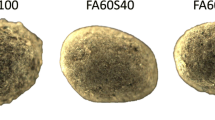Abstract
The article presents the results of physical and chemical properties of lightweight aggregates (LWA) obtained by the thermal treatments of raw composition based on fly ash, supplied by electric plants from Serbia. The production process of LWA consists of raw material preparation, plastic shaping–extrusion, granulation, and thermal treatment at three temperatures: 1100, 1150, and 1200 °C. The final firing temperature (T = 1150 °C) is chosen based on the mechanical and physical properties of the designed aggregates. The particle-size distribution of the LWAs is unimodal (d ≈ 16 mm) while the density value varies from 0.98 to 1.99 g/cm3. The water absorption values are determined by use of two methods: 24 h of soaking in cold water and 5 h of boiling. The thermal conductivity of unbound, fired LWA particles is determined by measuring the amount of axially transferred heat in the stationary state. The obtained value of the LWA thermal conductivity (λ = 0.0872 W/mK, T = 1150 °C) is suitable for the production of structural concrete blocks with improved thermal insulating properties. Because of their high-porosity and -compressive strength values, the designed LWA could be used instead of the conventional aggregates in the production of concrete blocks. Consequently, a real valorization of the waste material such as fly ash in Serbia was established.






Similar content being viewed by others
References
Yao Y, Yang DW, Zeng JL, Sun LX, Li WJ. Influences of fly ash and fluorgypsum on the hydration heat and compressive strength of cement. J Therm Anal Calorim. 2011;106:869–74.
Joshi C, Lothia RP. Fly ash in concrete: production, properties and uses. Advances in concrete technology. New York: Gordon and Breach Science Publishers; 1997.
Nochaiya T, Wongkeo W, Pimraksa K, Chaipanich A. Microstructural, physical, and thermal analyses of Portland cement–fly ash–calcium hydroxide blended pastes. J Therm Anal Calorim. 2010;100:101–8.
Bijen JMJM. Manufacturing processes of artificial lightweight aggregates from fly ash. Int J Cem Compos Lightweight Concr. 1986;8(3):191–9.
Ramamurthy K, Harikrishnan KI. Influence of binders on properties of sintered fly ash aggregate. Cem Concr Compos. 2006;28:33–8.
Verma CL, Handa SK, Jain SK, Yadav RK. Techno-commercial perspective study for sintered fly ash lightweight aggregates in India. Constr Build Mater. 1998;12:341–6.
Yang CC, Haung R. Approximate strength of lightweight aggregate using micromechanics method. Adv Cem Based Mater. 1998;7:133–8.
Majchhrzak-Kuceba I. Thermogravimetry applied to characterization of fly ash-based MCM-41 mesoporous materials. J Therm Anal Calorim. 2011. doi:10.1007/s1097301119088.
Neville AM. Properties of concrete. 4th ed. Harlow: Longman; 1995.
El-Gamal SMA, Hashem FS, Amin MS. Thermal resistance of hardened cement pastes containing vermiculite and expanded vermiculite. J Therm Anal Calorim. 2011. doi:10.1007/s1097301116809.
Li Y, Wu D, Zhang J, Chang L, Wu D, Fang Z, Shi Y. Measurement and statistics of single pellet mechanical strength of differently shaped catalysts. Powder Technol. 2000;113:176–84.
Hamdhan IN, Clarke BG. Determination of thermal conductivity of coarse and fine sand soils. In: Proceedings of World Geothermal Congress 2010, Bali, April 2010.
Komljenović M, Petrašinović-Stojkanović Lj, Baščarević Z, Jovanović N, Rosić A. Fly ash as the potetntional raw mixture component for Portland cement clinker synthesis. J Therm Anal Calorim. 2009;96:363–8.
Wardlaw NC, McKellar M, Yu L. Pore and throat size distributions determined by mercury porosimetry and direct observation. Carbonate Evaporites. 1988;3:1–15.
Kamseu E, Ceron B, Tobias H, Leonelli E, Bignozzi MC, Muscio A, Libbra A. Insulating behavior of metakaolin-based geopolymer materials assess with heat flux mater and laser flash techniques. J Therm Anal Calorim. 2011. doi:10.1007/s1097301117989.
Rice RW. Porosity of ceramics. Marcel Dekker Inc., Berlin; 1998.
Author information
Authors and Affiliations
Corresponding author
Rights and permissions
About this article
Cite this article
Zorić, D., Lazar, D., Rudić, O. et al. Thermal conductivity of lightweight aggregate based on coal fly ash. J Therm Anal Calorim 110, 489–495 (2012). https://doi.org/10.1007/s10973-012-2339-x
Published:
Issue Date:
DOI: https://doi.org/10.1007/s10973-012-2339-x




